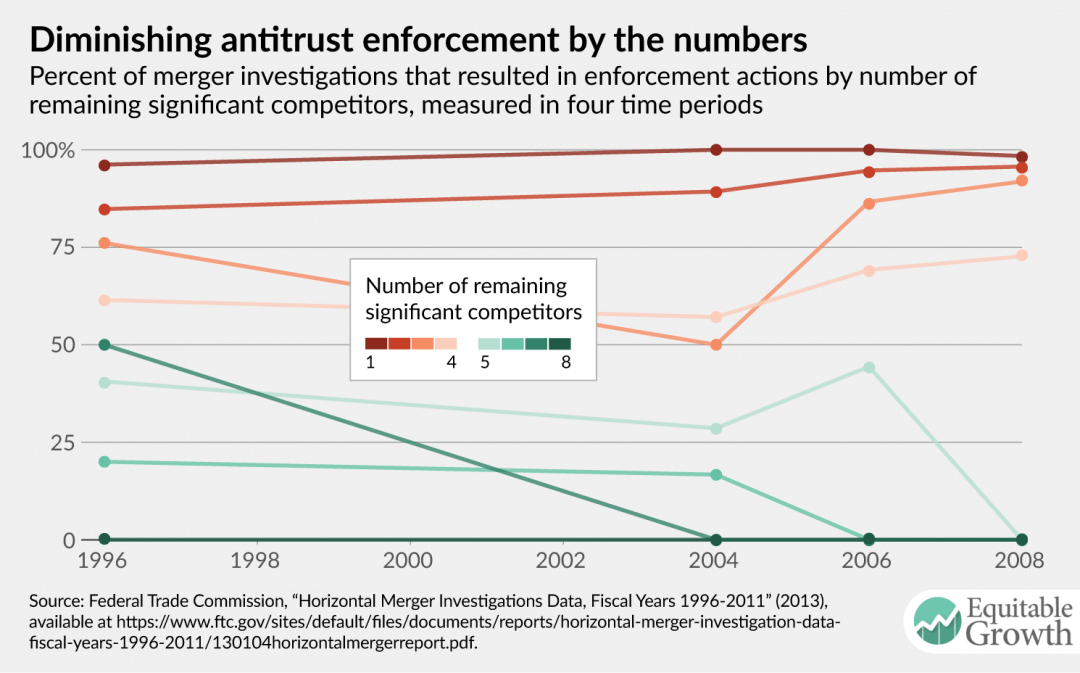Issue brief: U.S. antitrust and competition policy amid the new merger wave
Changes in merger enforcement policy have contributed to rising concentration and reduced competition
In a new paper in the Washington Center for Equitable Growth’s ongoing series on antitrust policy and its implications for the economic well-being of U.S. workers and consumers, John E. Kwoka of Northeastern University documents the rise in concentration and examines the evidence for one possible explanation: the change in merger enforcement policy at the Federal Trade Commission, or FTC, and the Antitrust Division of the U.S. Department of Justice.
Download FileIssue brief: U.S. antitrust and competition policy amid the new merger wave
Read the full PDF in your browser
Key findings
Examining FTC merger enforcement data from 1996 through 2011, Kwoka finds that merger enforcement narrowed its focus to mergers at the very highest levels of concentration and adopted a substantially more permissive stance toward mergers that consolidate industries up to that point. Specifically, his examination of the data reveals the following:
- Enforcement rates for mergers that would result in four or fewer remaining significant competitors slightly increased from 1996 through 2011.
- Enforcement for mergers that would result in more than four remaining significant competitors literally ceased after 2007: From 1996 through 2003, enforcement actions were taken in 36 percent of FTC merger investigations with five or more remaining competitors. By the 2008–2011 time period, that percentage had fallen to zero.

These findings are all the more interesting in light of earlier research that Kwoka has done. He has examined the level of concentration at which anti-competitive outcomes become nearly certain, finding that prices rose in nearly 95 percent of instances of mergers that resulted in six or fewer remaining significant competitors. It is in precisely this range of five to seven significant competitors where enforcement policy has shifted so dramatically over the past 20 years.
Explanations for the change in enforcement rates
- Kwoka lists several possible explanations for these observed changes in merger enforcement policy, including agency budget constraints.
- He focuses on changes in antitrust policy’s presumptions about the competitive consequences of increases in concentration. Over the past 50 years, those presumptions shifted from a viewpoint that held that even modest increases in concentration would result in above-competitive prices and profits to one in which it was believed that tougher merger standards sacrificed cost efficiencies, which presumably would be passed along to consumers.
- While antitrust policy has moderated somewhat from that “Chicago school” view, the FTC enforcement data from 1996 through 2011 nonetheless demonstrate that there has continued to be a shift away from merger enforcement actions in all but the most concentrated markets.
Policy implications
- Merger guidelines should be re-examined to ensure that policy hasn’t diverged from the evidence: When considering merger proposals, the thresholds used for the number of remaining significant competitors should reflect the point at which a merger might be presumed to increase an industry’s concentration to the point that it would lessen competition.
- Agency budgets should be expanded to ensure they have the necessary resources to vigorously pursue the merger cases that raise these concerns.
For more information
Please see “U.S. antitrust and competition policy amid the new merger wave,” by John E. Kwoka of Northeastern University for the Washington Center for Equitable Growth.

